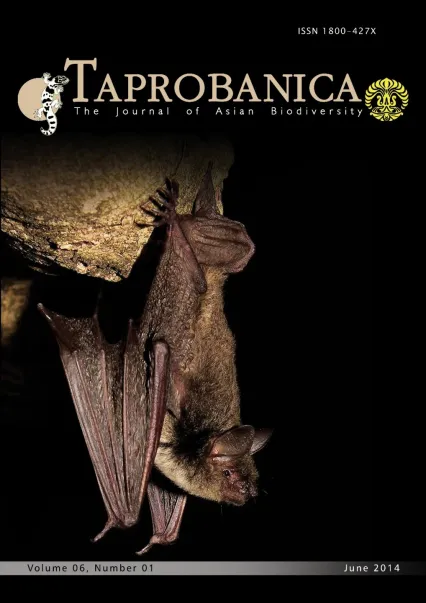

v6i1.136
Volume 6 | Number 1 | May 2014
Short Note
ISSN: 1800-427X (print)
eISSN: 1800-427X (online)
DOI:10.47605/tapro.v6i1.136
Submitted date: 18 November 2013
Accepted date: 1 May 2014
Published date: 29 June 2014
Pp. 68–71, Pl. 16.
A breeding colony of the brown bat (Myotis hasseltii) from Sri Lanka
S.M. Wellappulli-Arachchi, W.G.M. Edirisinghe*, D.S.B. Dissanayake, Y. Mapatuna & S. Wickramasinghe
*Corresponding author. E-mail: gayan.yza@gmail.com
Myotis hasseltii (Temminck, 1840) variously known as the brown bat, Van Hasselt’s bat, Van Hasselt’s mouse-eared bat, or lesser large-footed myotis in the vernacular is a patchily distributed species; aside from Sri Lanka, within the Indian Subcontinent it is found only in West Bengal. The brown bat is thought to be uncommon and is a resident of land below the 1000m contour. It has been reported to roost alone or in small groups in bamboo clumps, cracks in tree bark, and in abandoned buildings. Mangrove swamps are another possible habitat for these bats. M. hasseltii likes living near water and flies low over streams, tanks (reservoirs), and mangrove swamps hunting for gnats, small flies, and mosquitoes. Extralimitally, an individual of this species was found with fish remains in its stomach.
Section Editor: Asoka Yapa
eISSN: 1800-427X (online)
DOI:10.47605/tapro.v6i1.136
Submitted date: 18 November 2013
Accepted date: 1 May 2014
Published date: 29 June 2014
Pp. 68–71, Pl. 16.
A breeding colony of the brown bat (Myotis hasseltii) from Sri Lanka
S.M. Wellappulli-Arachchi, W.G.M. Edirisinghe*, D.S.B. Dissanayake, Y. Mapatuna & S. Wickramasinghe
*Corresponding author. E-mail: gayan.yza@gmail.com
Myotis hasseltii (Temminck, 1840) variously known as the brown bat, Van Hasselt’s bat, Van Hasselt’s mouse-eared bat, or lesser large-footed myotis in the vernacular is a patchily distributed species; aside from Sri Lanka, within the Indian Subcontinent it is found only in West Bengal. The brown bat is thought to be uncommon and is a resident of land below the 1000m contour. It has been reported to roost alone or in small groups in bamboo clumps, cracks in tree bark, and in abandoned buildings. Mangrove swamps are another possible habitat for these bats. M. hasseltii likes living near water and flies low over streams, tanks (reservoirs), and mangrove swamps hunting for gnats, small flies, and mosquitoes. Extralimitally, an individual of this species was found with fish remains in its stomach.
Section Editor: Asoka Yapa
- List of Articles & Contents





